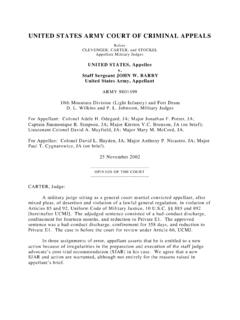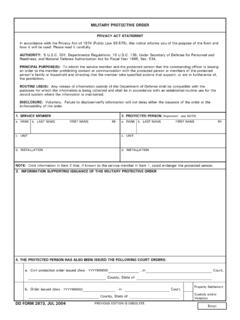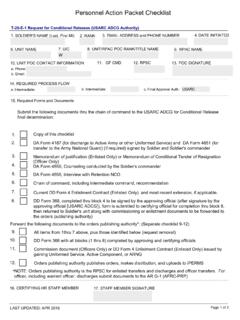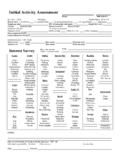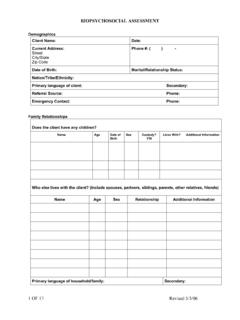Transcription of Testing Instructions - Judge Advocate General's Corps ...
1 Testing InstructionsOccupational Physical assessment Test (OPAT)The Occupational Physical assessment Test (OPAT) is a battery of four physical fitnesstest events that will be used to assess an individual s physical capabilities to engagephysically demanding Army tasks. The OPAT provides measurements of upper- and lower-body power, lower-body strength and aerobic endurance. The OPAT test events are: thestanding long jump, seated power throw, strength deadlift and the interval aerobic run. Thestanding long jump, seated power throw and strength deadlift can be performed in any order;however the interval aerobic run must be performed as the last event.
2 Individuals areauthorized to take up to 5 minutes to recover between events, but may elect to proceed PROCEDURESP rior to or on the test day, individuals will be briefed on the purpose and organization of thetestThe following Instructions areREAD aloud to all individuals taking the OPAT. YOU ARE ABOUT TO TAKE THE OCCUPATIONAL PHYSICAL assessment TEST OROPAT. THEOPATWILLMEASUREYOURUPPER-ANDLOWER-BOD YPOWER,LOWER-BODY STRENGTH AND AEROBIC CAPACITY. THE RESULTS OF THE OF THE OPATWILL SERVE AS A GUIDE IN DETERMINING YOUR PHYSICAL CAPABILITIES. AT THIS TIME THE TEST ADMINISTRATOR WILL HAND YOU YOUROPAT SCORECARD.
3 YOU ARE TO CARRY YOUR SCORECARD WITH YOU TO EACH EACH TEST EVENT, HAND YOUR SCORECARD TO THE SCORER. AFTER YOUCOMPLETE THE EVENT, THE SCORER WILL RECORD YOUR SCORE, INITIAL THE CARDAND RETURN IT TO YOU. LISTEN CLOSELY TO THE TEST Instructions . ASK QUESTIONSBEFORE BEGINNING, OR DURING THE TEST, IF THE Instructions ARE NOT CLEAR TO YOUR BEST O N E AC H TEST EVENT. Prior to the execution of the OPAT, the test administrator should conduct a dynamicwarm-up to ensure individuals are adequately prepared to perform at a maximumlevel for each of the four OPAT events.
4 Standing Long JumpSeated Power ThrowStrength DeadliftInterval Aerobic RunFigure 1. OPAT eventsSTANDING LONG JUMP Instructions : THE PURPOSE OF THE STANDING LONG JUMP IS TO ASSESS LOWER- BODY POWER. YOUWILL STAND BEHIND THE TAKE-OFF LINE WITH YOUR FEET PARALLEL AND SHOULDER-WIDTHAPART. YOU WILL JUMP AS FAR AS POSSIBLE WITH A TWO-FOOT TAKE-OFF AND LANDING. YOUARE ALLOWED TO ROCK ON YOUR TOES AND HEELS, BUT YOUR FEET CANNOT BE RAISEDOFF THE G R O U N D BEFORE THE JUMP. THE JUMP BEGINS BY MOVING BOTH ARMSFORWARD AND BACKWARD (ARM COUNTER-MOVEMENTS) WHILE BENDING AT THE KNEES ANDHIPS.
5 DO NOT MOVE YOUR FEET AFTER LANDING. AFTER LANDING IF YOU MOVE YOUR FEETYOU MAY BE ASKED TO REPEAT THE JUMP. IF YOU FALL BACKWARD YOU WILL REPEAT THEJUMP. YOUPERFOTWO SUB-MAXIMAL PRACTICE JUMPSFOLLOWED BY THREEMAXIMUM EFFORT JUMPS. THE JUMP IS SCORED TO THECLOSEST CENTIMETER FROM THE HEEL CLOSEST TO THE TAKE-OFF LINE. WATCH THISDEMONSTRATION. Figure 2. Standing long jump STANDING LONG JUMP CHECKPOINTS:During the execution of the standing long jump, the scorer will focus on thefollowing:1. Ensure the individual s toes are behind the take-off line, feet are paralleland approximately shoulder-width 3.
6 Standing long jump starting position2. Individuals may perform several counter-movements (swinging arms forward andbackward while bending the knees) before jumping as far forward as 4. Standing long jump counter movement3. Ensure individual does not take a small hop or step prior to executing thestanding long 5. Hop or step prior to the jump 4. ITwo Sub-maximalThree Successful JumpsPractice JumpsFigure 6. Sub-maximal practice and successful jumps5. If an individual falls forward or backward and/or moves their feet, the jump doesnot count and the jump will be ForwardFalling BackwardMoving Feet Priorwith Foot Movementto ScoringFigure 7.
7 Movements that cause the jump to be repeated6. The distance for each jump is recorded to the closest centimeter (cm) bymeasuring from the take-off line to back of the heel closest to the take-off 8. Scoring the standing long jump WHAT ARE YOUR QUESTIONS ABOUT THE STANDING LONG JUMP? Measurement is takenfrom takeoff line to theheel closest to thetakeoff line incentimeters (cm). SEATED POWER THROW Instructions : THE PURPOSE OF THE SEATED POWER THROW IS TO ASSESS UPPER-BODY POWER. DURINGTHE TEST, YOU WILL SIT ON THE FLOOR WITH YOUR LOWER BACK AGAINST THE YOGA BLOCKAND UPPER BACK AGAINST THE WALL.
8 YOUR HE AD W I LL N O T T O U CH T H E W AL L . YOURLEGS W I LL BE EXTENDED STRAIGHT OUT IN FRONT OF YOU. YOU WILL HOLD THE MEDICINEBALL WITH TWO HANDS. WHEN I SAY GO , BRING THE MEDICINE BALL TO YOUR CHESTWITH YOUR ELBOWS COMFORTABLY AT YOUR SIDES. YOU WILL PAUSE BRIEFLY, THENPUSH/THROW THE MEDICINE BALL UPWARDS AND OUTWARDS AT A 45 ANGLE. TO MAXIMIZETHE DISTANCE OF THE THROW, FOLLOW THROUGH BY FLEXING YOUR WRISTS. DO NOT THROWTHE MEDICINE BALL LIKE SHOOTING A basketball . THE DISTANCE OF YOUR THROW WILL BEMEASURED FROM THE WALL TO THE SPOT THE BALL LANDS.
9 YOU WILL BE O F F E R E D TWOPRACTICE THROWS. AFTER THE PRACTICE THROWS, YOU WILL PERFORM THREE MAXIMALEFFORT THROWS. IF YOU FAIL TO MAINTAIN CONTACT WITH THE WALL, YOU WILL REPEAT THETHROW. THE THROW IS SCORED FROM THE WALL TO THE NEAREST 10 CENTIMETERS FROMWHERE THE BALL CONTACTS THE THIS DEMONSTRATION. Figure 9. Seated power throwSEATED POWER THROW CHECKPOINTS:During the execution of the seated power throw, the scorer will focus on thefollowing:1. Ensure the individual s upper back maintains contact with wall and lower backwith the yoga 10.
10 Seated power throw starting positionUpper-backmaintainscontact with the with the yogablock. 2. The individual s starting position should be with the arms comfortably at thesides with the ball touching the middle of the 11. Seated power throw starting position3. Individuals should attempt to throw the medicine ball using equal force from both arms:Correct Throwing MotionIncorrect Throwing MotionFigure 12. Seated power throwing motion WHAT ARE YOUR QUESTIONS ABOUT THE SEATED POWER THROW? STRENGTH DEADLIFT deadlift practice repetitions (D-handles up)Figure 14.
